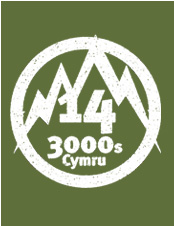
back to archiveDon't do this at home.
33 miles and 14,500 feet of ascent. That was the day’s walk ahead of us as we started, in darkness, from Pen y Gwryd at a quarter to five in the morning on a venture whose planning had occupied the previous evening. The round trip returning to the starting point was to include the fourteen three thousand foot summits of Wales.
Thick cloud prevented the half moon from illuminating our path to the extent hoped for, but the road to Pen y Pass glinted like a dull ribbon as the gentle padding of our feet on the macadam echoed off the stone boundary walls. At the top of the pass we swung from the highway onto the rocks at the start of the Pig Track. The pace dropped as we stumbled through the darkness and it was not easy to keep to the track. On the broad lower slopes of the ridge leading to Crib Goch, the first peak, startled sheep hurriedly made way for the two shadowy figures suddenly appearing.
Intimate knowledge of the rock scramble below the sharp peak of Crib Goch made the dark climb safe and enjoyable. As we reached the summit the horizon behind us began to glow a dull red and, almost imperceptibly, the light increased. The gentle wind nudged us along the knife edge arete. The Pinnacles at the end were unashamedly bypassed to save a few precious minutes. It was a rare experience to traverse Crib y Ddysgyl onto Snowdon without any other climbers in sight. The reigning peak, hiding in cloud, was reached through the mist and some drizzle at ten minutes to seven.
It was too cold to linger, with no view to admire, so after the briefest stop to consume a sandwich or two we trotted down the railway track. From Clogwyn station there was a momentary glimpse of the vast panorama unfolding as we dipped below the mist. We slid off the edge of the ridge into the gloomy depths of Cwm Glas Bach, and knees took their first real punishment as the remaining 3000 feet of height was quickly shed.
A scheduled ten minute rest at a climbing hut in Nant Peris gave us a chance to eat and rest to gather strength for the longest ascent of the day, the heartbreaking pull up the grassy flank of Elidyr Fawr. This, the biggest reascent of the fourteen peaks traverse, is the key to its successful accomplishment; it is here that the unfit climber will fail, where is fought the battle between the mental stamina to keep going and the temptation to abandon the walk in favour of the comforts of the valley below. After about an hour of relentless slogging the boulder strewn slopes below the summit were reached and the crowning cairn found. We flopped down in relief, but after a few minutes rest we were pounding along the almost level ridge forming the wall of the Nant Ffrancon valley. This long grassy ridge leading to Y Garn is one of the easiest sections of the walk allowing time to admire the Snowdon and Carneddau massifs on opposite sides. On our right, smoke pin pointed the first train ascending Snowdon whose summit still slept in the clouds; on our left, the Carneddau seemed to be gathering cumulus clouds in preparation for our welcome. Nowhere could we see any other climbers on the hills. Down in the Nant Ffrancon valley at our feet the holiday traffic crawled in slow procession along Telford’s highway.
By comparison with the earlier gruelling ascents, Y Garn appeared level, but we were working up a thirst in the dry air, and we hastened down to the refreshing streams above the Devil’s Kitchen. The ascent of Elidyr Fawr had taken its toll and it was here that my companion reluctantly had to retire from the fray and take the direct track down to Llyn Ogwen.
I now made a solitary twenty minute effort on the scree slope to reach the summit of Glyder Fawr at 11 a.m.. Like Snowdon, its plateau (pictured - Ed) was strangely deserted as I crossed over the rocky bastion of Castell y Gwynt to Glyder Fach. These wild, splintered summits conjured up visions of what mountaineering on the Moon might be like, but in reality they formed a central viewing platform for the whole of Snowdonia in a huge landscape of mountains, valleys, lakes and sea.
Regretfully, I left this wonderful scene and plunged down the screes and scrambled over huge blocks up to the summit of Tryfan. This was the popular peak of the day; it was the only one where I met other climbers, for there were many of them coming down the South ridge. By now I was extremely tired. Clattering rather ponderously down the stony steep groove of West Gully I reached the half way stage at Glandena, where my friends, in support, were waiting with encouraging food and hot drink. The twenty minutes rest and refreshment sent me off feeling as if it were the beginning of the day. Speeding past Tal Llyn Ogwen farm I pounded up the grassy slopes near the white ribbon of the Afon Lloer to the hidden lake of Ffynnon Lloer and followed the East ridge of Pen Yr Oleu Wen to reach its summit in fifty one minutes, an encouraging boost to morale which had faded on Tryfan an hour or so earlier. This peak was now seen end on, a formidable rock bastion backed by the dark precipitous north wall of the Glyders. By contrast, the Carneddau looked calm and tranquil, with broken cumulus cloud producing dappled sunlight effects on the vast grassy expanse. To the north west the whole of Anglesey sprawled across the sea like a map. Again, there was no one present to share this panoramic vista of the highest hills in Wales.
But this was not the time for leisurely view gazing, and the urgency of the business in hand soon had me scampering along the broad grassy ridge to the rough stony top of Carnedd Dafydd, one of the few three thousand footers favoured with a concrete triangulation pillar. The ever threatening mists descended again and the compass was brought out to check the direction of Craig Llugwy. While traversing the narrow undulating ridge leading to Carnedd Llewelyn, glimpses through holes in the mist revealed the vast expanse of elevated moorland of the Carneddau. A few hundred feet below the summit of Carnedd Llewelyn a swing to the north west was made to meet the ridge between Carnedd Llewelyn and Yr Elen near its lowest point, thus saving a few hundred feet of re-ascent. Yr Elen, as often, was clear of the mist and from this vantage point the scene extended from the Black Ladders to Bethesda, with Anglesey seemingly only a stone’s throw across the Menai Straits.
Now a red helicopter appeared, and after several practice landings on the lower slopes, it circled overhead like an eagle searching for its prey. I did not dare to wave lest a misunderstanding might cause me to be winched off the mountain which would have been a frustrating end to the venture. A short re-ascent led to the stony wastes of Carnedd Llewelyn, only a little lower than Snowdon, and the summit cairn was located after a brief search in the mist.
The nature of the journey now changed. The vast distances across comparatively level grassy moorland were covered at a brisk trot, once the slippery rocks on the north side of Carnedd Llewelyn had been negotiated. In about a quarter of an hour the stony top of Foel Grach was reached, and its new emergency refuge passed immediately north of it. As mist still covered most of the vast plateau, Garnedd Uchaf was used as an intermediate objective before changing compass bearing for the distant Foel Fras. After following the wall to the cairn on this summit, the last of the fourteen three thousanders, a rest was taken; this was the furthest point from the start, and now the shortest possible return route remained. Looking back at Carnedd Llewelyn, which was beginning to shed its misty veil, and the Glyders beyond, the vast distance to be retraced could be seen, and I began to wonder whether I could complete it on the schedule which left little daylight to spare.
Once the effort of getting up and moving had been made, I surprisingly reached Carnedd Llewelyn in a shorter time than on the outward trot; perhaps the thought of hot tea waiting at Glandena spurred me on. After checking with the compass on the summit to avoid the mistake of following the Pen Helgi Ddu ridge instead, the connecting ridge to Carnedd Dafydd suddenly appeared in the verdant green splendour which I had never before seen. The clouds rolled back and now the Glyders sparkled in the sun as the sky provided a beautiful blue backcloth. The traverse to Craig Llugwy provided a few minutes to contemplate this scene before bounding down boggy grass slopes and finally running down to Glandena where my loyal supporters were waiting with flasks of tea. Never was a hot drink so welcome. Tired as I was, I felt that I could not abandon the walk with a mere three and a half miles to go over the wall of the Glyders. At this point my energetic companion, who had dropped out after the first eleven miles, joined in again for the last stage, and started ahead while I took refreshment. Crossing the A5 highway, some extremely wet bog was waded through to reach the old valley road; the ground became drier as it rose into the defile between the smooth rock slab of Tryfan Bach and the boulders at the foot of its more distinguished parent. There was a semblance of a path, but rough heather covering it made this the hardest struggle of the day. Legs which had been trained to long uphill slogs by ascending Mont Blanc, the Matterhorn, and Monte Rosa a few weeks before, now wilted on such rough ground. After a mile of this, the only reward was an even steeper scree slope onto the Miners’ track on the shoulder of Glyder Fach. Together again, we laboured up onto this col, but there the Miners’ track vanished through lack of cairns, so we aimed in the direction of Pen-y-Gwryd hidden beneath the brow of this vast mountain. As we laboured through very rough ground, the Snowdon range ahead basked in the pinkish low sunlight and reminded us of our visit there twelve hours previously. To our left, Moel Siabod sulked, not having received a visit owing to its lack of a few extra feet of height. The distant sea in Cardigan bay sparkled, and mountains, lakes, sea and sky contributed to the feeling of elation as the walk now seemed certain to be completed ahead of the target time.
Suddenly Pen-y-Gwryd appeared and we corrected course directly towards it. The ground now dropped steeply in rock strewn heather slopes, and weary legs plunged painfully down with feet landing awkwardly, sending spasms of pain through battered ankles, but speed was maintained with the end in sight. The final run in aside the Gwryd stream was a veritable gallop, so much so that my companion tripped on the turf, fell forward, and rolled back onto his feet with no change of pace.
At Pen-y-Gwryd, our watches showed that we had completed the course eight minutes ahead of the fifteen hour schedule, beating my previous time for this round by thirty five minutes. This enjoyable and satisfying venture justified the preparation and training for it. The fourteen three thousanders are among the finest mountains in these islands, and few expeditions could be more satisfying than a traverse of all these summits in a single day.




